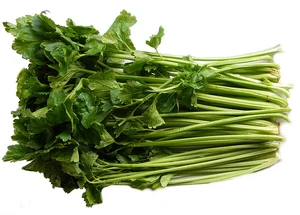mNo edit summary |
|||
| (6 intermediate revisions by 4 users not shown) | |||
| Line 1: | Line 1: | ||
| − | <div style="clear:both;margin:1.6em 3px .8em 3px"> |
+ | <div style="clear:both;margin:1.6em 3px .8em 3px"> |
<p style="font-variant: small-caps; text-align: center; margin-bottom:.2em; font-size: 105%;">'''[[:Category:Chinese celery Recipes|Browse All Chinese celery Recipes]]''' </p></div> |
<p style="font-variant: small-caps; text-align: center; margin-bottom:.2em; font-size: 105%;">'''[[:Category:Chinese celery Recipes|Browse All Chinese celery Recipes]]''' </p></div> |
||
| − | [[Image:|thumb|300px |
+ | [[Image:chinese_celery.jpg|thumb|300px|Chinese celery]] |
| − | ==About Chinese celery== |
+ | == About Chinese celery == |
Celery is also known under the name of apium graveolens and has an interesting name origin. The celery name comes from the Greek word “selinon”, which was used in the famous Odyssey of Homer. Obviously, celery is an ancient aliment and the Chinese people were among the first ones who used it, sometimes back in the 5th century AD. Although celery has 2 distinctive origins, the European and the Chinese (or Asian), the main difference between the 2 is the fact that the Chinese celery’s color ranges from the plain white till darker tones of greens. Besides the appearance, the Chinese celery also differs in taste, as it has a more intensive flavor that the regular European celery, which is also constant in its color: forest green. |
Celery is also known under the name of apium graveolens and has an interesting name origin. The celery name comes from the Greek word “selinon”, which was used in the famous Odyssey of Homer. Obviously, celery is an ancient aliment and the Chinese people were among the first ones who used it, sometimes back in the 5th century AD. Although celery has 2 distinctive origins, the European and the Chinese (or Asian), the main difference between the 2 is the fact that the Chinese celery’s color ranges from the plain white till darker tones of greens. Besides the appearance, the Chinese celery also differs in taste, as it has a more intensive flavor that the regular European celery, which is also constant in its color: forest green. |
||
| + | |||
| + | Chinese celery is a smaller version of the celery in Western markets, but its flavor is quite a bit stronger. The crisp, hollow stems of some varieties are light green, while others can be dark green or white. The leaves are typically jagged on the edges. |
||
Celery is mostly used in addition for various soups, which include meat or veggies and it is also a basic ingredient for the stir-fries. In most of the cases, celery is chopped fresh, but this plant is also popular for decorating foods for a fresh and sophisticated appearance. |
Celery is mostly used in addition for various soups, which include meat or veggies and it is also a basic ingredient for the stir-fries. In most of the cases, celery is chopped fresh, but this plant is also popular for decorating foods for a fresh and sophisticated appearance. |
||
| − | ==[[:Category:Chinese celery Recipes|Chinese celery Recipes]]== |
+ | == [[:Category:Chinese celery Recipes|Chinese celery Recipes]] == |
| + | |||
| + | |||
| + | http://www.epicurious.com/recipes/food/views/Creamy-Chinese-Celery-Soup-107735 |
||
| + | http://chinesefood.about.com/od/vegetablesrecipes/r/chinese_celery.htm |
||
| ⚫ | |||
[[Category:Chinese Vegetables]] |
[[Category:Chinese Vegetables]] |
||
| ⚫ | |||
Latest revision as of 22:12, 29 February 2012

Chinese celery
About Chinese celery
Celery is also known under the name of apium graveolens and has an interesting name origin. The celery name comes from the Greek word “selinon”, which was used in the famous Odyssey of Homer. Obviously, celery is an ancient aliment and the Chinese people were among the first ones who used it, sometimes back in the 5th century AD. Although celery has 2 distinctive origins, the European and the Chinese (or Asian), the main difference between the 2 is the fact that the Chinese celery’s color ranges from the plain white till darker tones of greens. Besides the appearance, the Chinese celery also differs in taste, as it has a more intensive flavor that the regular European celery, which is also constant in its color: forest green.
Chinese celery is a smaller version of the celery in Western markets, but its flavor is quite a bit stronger. The crisp, hollow stems of some varieties are light green, while others can be dark green or white. The leaves are typically jagged on the edges.
Celery is mostly used in addition for various soups, which include meat or veggies and it is also a basic ingredient for the stir-fries. In most of the cases, celery is chopped fresh, but this plant is also popular for decorating foods for a fresh and sophisticated appearance.
Chinese celery Recipes
http://www.epicurious.com/recipes/food/views/Creamy-Chinese-Celery-Soup-107735
http://chinesefood.about.com/od/vegetablesrecipes/r/chinese_celery.htm
